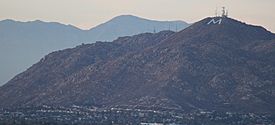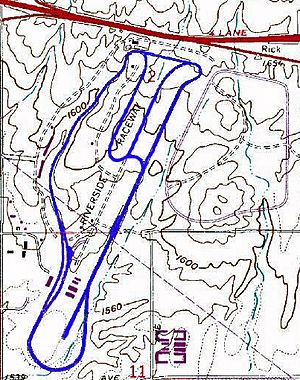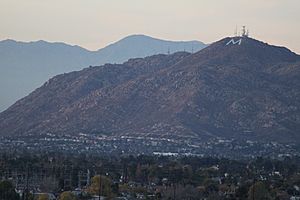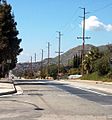Moreno Valley, California facts for kids
Quick facts for kids
Moreno Valley, California
|
|||
|---|---|---|---|
| City of Moreno Valley | |||
|
Clockwise: the giant "M" on Box Springs Mountain for "Moreno Valley"; shops in Moreno Valley; aerial view of Moreno Valley; Sunnymead Ranch Lake.
|
|||
|
|||
| Nickname(s):
"MoVal"
|
|||
| Motto(s):
"Where Dreams Soar"
|
|||
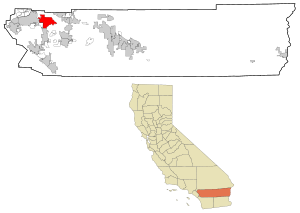
Location in Riverside County and the state of California
|
|||
| Country | United States | ||
| State | California | ||
| County | Riverside | ||
| Incorporated | December 3, 1984 | ||
| Government | |||
| • Type | Council-Manager | ||
| Area | |||
| • Total | 51.51 sq mi (133.41 km2) | ||
| • Land | 51.30 sq mi (132.86 km2) | ||
| • Water | 0.21 sq mi (0.55 km2) 0.39% | ||
| Elevation | 1,631 ft (497 m) | ||
| Population
(2020)
|
|||
| • Total | 208,634 | ||
| • Rank | 2nd in Riverside County 20th in California 109th in the United States |
||
| • Density | 4,153.36/sq mi (1,603.62/km2) | ||
| Time zone | UTC−8 (Pacific) | ||
| • Summer (DST) | UTC−7 (PDT) | ||
| ZIP codes |
92551–92557
|
||
| Area codes | 909, 951 | ||
| FIPS code | 06-49270 | ||
| GNIS feature IDs | 1668251, 2411159 | ||
Moreno Valley is a city in Riverside County, California, and is part of the Riverside–San Bernardino–Ontario metropolitan area. It is the second-largest city in Riverside County by population and one of the Inland Empire's population centers. As of the 2020 census, the city's population was 208,634. Moreno Valley is also part of the larger greater Los Angeles area.
The city derived its name from the small community of Moreno, which became part of the city of Moreno Valley when the city was incorporated in 1984. Frank E. Brown, one of the founders of the community of Moreno in 1882, declined to have the town named after him, but to honor him, the town was named Moreno, Spanish for brown.
Contents
History
Prehistory to 1800s
The Moreno Valley area was first inhabited 2,300 years ago. There are at least 190 prehistoric archaeological locations within the city. The majority of the sites are milling stations - where chaparral seed was the dominant milling activity. Rock art, consisting of pictographs, and petroglyphs are present - though most of the petroglyphs in Moreno Valley consist of boulders with "cupules", or cup-shaped holes pecked into them.
Spanish scouts initially came across descendants of the Shoshone, and Luiseño tribes; although other groups, such as the Serrano and Cahuilla were in the area. The late prehistoric Luiseño and Cahuilla were semi-sedentary, meaning that they wintered in villages, then spread out in family groups during the spring and summer months to harvest seeds and acorns.
Spanish scouts blazed a number of trails in the area, including the Anza Trail, which runs through the Edgemont area of present-day Moreno Valley.
U.S. settlement
When California was admitted to the United States as a state in 1850, Americans began to move into the area. The Tucson-to-San Francisco route of John Butterfield's Overland Mail Company passed through. Some farmers began to occupy the area, relying upon water from Frank E. Brown's Bear Valley Land and Water Company. Beginning in 1883, the company collected and pumped water from Bear Valley, California in the San Bernardino Mountains to the north. The area first acquired its current name, Moreno Valley, at this time, referring to Frank Brown (moreno is Spanish for "brown" or "brunet"). In 1899, the city of Redlands won a lawsuit in which the city claimed eminent domain over the Bear Valley water. The resulting loss of service forced most of the area's inhabitants to move.
20th Century
The revival of the Moreno Valley area began in 1918, when the United States Air Force (then the United States Army Air Service) constructed March Field on the outskirts of Riverside as part of its World War I expansion. March Field was initially used to train fighter pilots. Although it was closed in 1922, it was reopened in 1927 and eventually became a full Air Force base. The presence of March caused the unincorporated communities of Sunnymead, Moreno, and Edgemont to develop and grow. In World War II, March again became a training ground for military pilots. On April 1, 1996, March Air Force Base (MAFB) became March Joint Air Reserve Base (MJARB) under Air Force Reserve Command (AFRC).
From 1957 to 1989, the Riverside International Raceway occupied the current site of the Moreno Valley Mall. The Riverside International Raceway (Sometimes known as RIR or Riverside Raceway) race track was in operation from September 22, 1957, to July 3, 1989. Races held at the Riverside International Raceway included IMSA, NASCAR, Indycar, NHRA drag racing, Go Karts, and AMA motorcycle racing.
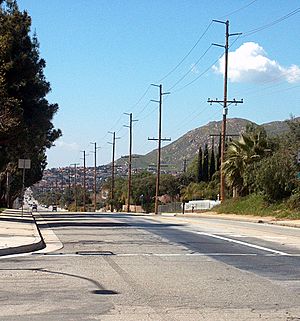
.
Incorporation and growth
The area experienced explosive growth in the 1980s. By 1984, the population was 49,702 (compared to 18,871 residents in 1970). The state economic boom fueled the construction of new houses and businesses. This growth led to a push for incorporation. Although similar measures had failed in 1968 and 1983, a measure to form the city of Moreno Valley was approved by voters in 1984. On December 3, 1984, the communities of Edgemont, Sunnymead, and Moreno united with nearby areas to form the general law city of Moreno Valley. The first City Council was also elected in 1984, composed of Bob Lynn, Judith A. Nieburger, Steven Webb, J. David Horspool (first Mayor Pro Tem), and Marshall C. Scott (first Mayor). The City Seal and Motto were adopted the following year.
By 1990, Moreno Valley had exploded in population growth to become the second largest city in Riverside County with a population of over 118,000. Growth continued until about 1992.
In the 1990s, the robust Moreno Valley economy deteriorated, largely due to the statewide economic downturn. Many people began to leave the city. March was also downsized to its present status as March Air Reserve Base. The surplus land was given to the March Joint Powers Authority, made up of representatives of Riverside County and the cities of Riverside, Moreno Valley, and Perris for development. The dismal economic trend began to reverse in the late part of the decade, however. Companies such as Aurora Modular, U-Haul, and Lowe's moved major operating facilities to the city or neighboring municipalities (although Aurora later filed for bankruptcy).
By the early 21st century, the arrival of so many newcomers to Riverside County and the soaring cost of living in Los Angeles and Orange County combined to make the less-developed southern half of the Inland Empire a very attractive place for industry.
On the east end of the city off Moreno Beach Drive, a new Wal-Mart was opened in early 2006 (233,000 sq ft (21,600 m2) next to the Moreno Valley Auto Mall. This is also the site of the first Super Target in California and the first Best Buy store located within Moreno Valley city limits, which opened in July and October 2007, respectively. The exit off state route 60 is the main way to the Moreno Valley Ranch Golf Course, once included in Golf Magazine's Top 75 Golf Courses in the USA.
March Air Reserve Base
Proposals to turn March Joint Air Reserve Base to a major commercial airport was been debated in 2005, but the plan was rejected by the Riverside county board of supervisors. However, the coming of quieter, more environmentally friendly aircraft and cheaper security procedures and utilities may signal a re-consideration of the plan. In May 2008 the March JPA approved opening the facility to general aircraft.
DHL's selected March Air Reserve Base as its Southern California hub and commenced operations in October 2005. In November 2008, DHL announced it was leaving the U.S. market and would shut its operation associated with March Air Field in January 2009.
March Air Reserve base has a ball park facility, where the semi-pro baseball Inland Empire (now Rancho Belago) Rockets of the Southern California League play in the summer months season.
21st Century
On February 13, 2007, the City Council passed, by a vote of 4–1, a controversial resolution christening the eastern half of the city (roughly from Lasselle Street to Gilman Springs Road) "Rancho Belago", a pastiche of Spanish and Italian words. The city council's resolution includes the 92555 ZIP Code within the boundaries of the area, as reported by the Press Enterprise newspaper.
Today, Moreno Valley is home to around 200,000 residents and once again, experienced an economic bust (the late 2000s Recession) to restart again in a new development boom. MetroLink rail transit has arrived in the area further down in Perris to the south and a proposal to erect a four-lane freeway on the site of Cajalco Road/Ramona Expressway from Interstate 215 to Interstate 15 in Corona is currently debated by the CalTrans, Riverside County and Orange County governments. Upper-middle class residents reside in newer housing developments on the eastern half of the city. Recent years have seen the rise of corporate office industrial and business parks, as well a proposal of bringing minor league baseball of the California League to town. Moreno Valley is rapidly becoming a Latino majority city (over 50+ percent) and now has a high percentage of African-Americans (18.0% according to the 2010 U.S. Census).
Geography
According to the United States Census Bureau, the city has a total area of 51.5 square miles (133 km2), of which, 51.3 square miles (133 km2) of it is land and 0.2 square miles (0.52 km2) of it is water.
Moreno Valley is located at a geographic crossroad. To the east lie the San Gorgonio Pass and Coachella Valley; to the south are Lake Perris, Perris, the San Jacinto Mountains, and the route to San Diego; to the north are the San Bernardino Valley and San Bernardino Mountains. To the west lies neighboring Riverside, as well as Los Angeles and Orange Counties. The heavily traveled routes of State Route 60 (locally called the Moreno Valley Freeway) and Interstate 215 both pass through the city. It lies under approach paths for Los Angeles International Airport, John Wayne Airport in Orange County, LA/Ontario International Airport and San Bernardino International Airport.
One of the most visible geographical features in Moreno Valley, visible from almost anywhere in the city, is Box Springs Mountain. This mountain at the northwest end of the city towers over the city, providing a concrete landmark. The face of the mountain that faces the city has a large "M" constructed upon it. This was built privately at the encouragement of the City Council, which argued it would foster unity. The letter is located on public land and is maintained entirely by charity. The letter had lights installed on December 3, 2005 to celebrate Moreno Valley's 21st anniversary of its incorporation and the completion of the repairs of heavy damage to the M, due to excessive rain the year before. The mayor at that time, Bonnie Flickinger, has said that the citizens liked it that way and that the council would try to get it to light up regularly. Between December 2, 2009 and December 6, 2009, Moreno Valley, along with Edison lit up the "M" in celebration of the city's 25th anniversary. Several Eagle Scout projects have been dedicated to maintaining the letter.
Climate
Moreno Valley has a mild semi-arid climate (Köppen BSh), with Mediterranean characteristics. The summer temperatures average in the low to mid 90s, though many days can reach well above 100°.
- On average, the warmest month is August.
- The highest recorded temperature was 113 °F (45 °C) in 1960.
- On average, the coolest month is December.
- The lowest recorded temperature was 22 °F (−6 °C) in 1974.
- The maximum average precipitation occurs in December.
| Climate data for Moreno Valley, California | |||||||||||||
|---|---|---|---|---|---|---|---|---|---|---|---|---|---|
| Month | Jan | Feb | Mar | Apr | May | Jun | Jul | Aug | Sep | Oct | Nov | Dec | Year |
| Record high °F (°C) | 97 (36) |
92 (33) |
98 (37) |
104 (40) |
108 (42) |
112 (44) |
113 (45) |
112 (44) |
113 (45) |
108 (42) |
98 (37) |
93 (34) |
113 (45) |
| Average high °F (°C) | 68 (20) |
68 (20) |
71 (22) |
76 (24) |
81 (27) |
87 (31) |
94 (34) |
95 (35) |
91 (33) |
83 (28) |
74 (23) |
67 (19) |
80 (26) |
| Average low °F (°C) | 43 (6) |
44 (7) |
46 (8) |
49 (9) |
54 (12) |
57 (14) |
62 (17) |
62 (17) |
59 (15) |
53 (12) |
46 (8) |
42 (6) |
51 (11) |
| Record low °F (°C) | 24 (−4) |
27 (−3) |
29 (−2) |
33 (1) |
38 (3) |
44 (7) |
49 (9) |
49 (9) |
42 (6) |
32 (0) |
26 (−3) |
22 (−6) |
22 (−6) |
| Average precipitation inches (mm) | 2.33 (59) |
2.50 (64) |
.68 (17) |
.45 (11) |
.31 (7.9) |
.01 (0.25) |
0 (0) |
0 (0) |
.08 (2.0) |
.32 (8.1) |
.74 (19) |
5.24 (133) |
12.75 (324) |
Demographics
| Historical population | |||
|---|---|---|---|
| Census | Pop. | %± | |
| 1990 | 118,779 | — | |
| 2000 | 142,381 | 19.9% | |
| 2010 | 193,365 | 35.8% | |
| 2020 | 208,634 | 7.9% | |
| U.S. Decennial Census | |||
2017 Estimates
As of 2017, estimates from City-Data show that Moreno Valley's population was 207,226. It had 128,912 Latinos/Hispanics of any race (62.2%); 32,932 Black alone (15.9%); 27,586 White alone (13.3%); 12,510 Asian alone (6.0%); and 1,180 Native Hawaiian and Pacific Islander alone (0.6%). The population density was 4,045 people per square mile.
2010
The racial makeup of Moreno Valley was 36,546 (18.9%) non-Hispanic White, 34,889 (18.0%) African American, 1,721 (0.9%) Native American, 11,867 (6.1%) Asian, 1,117 (0.6%) Pacific Islander, 51,741 (26.8%) from other races, and 11,061 (5.7%) from two or more races. Hispanic or Latino of any race were 105,169 persons (54.4%).
The Census reported that 192,811 people (99.7% of the population) lived in households, 471 (0.2%) lived in non-institutionalized group quarters, and 83 (0.1%) were institutionalized.
There were 51,592 households, out of which 28,586 (55.4%) had children under the age of 18 living in them, 29,000 (56.2%) were opposite-sex married couples living together, 9,990 (19.4%) had a female householder with no husband present, 4,191 (8.1%) had a male householder with no wife present. There were 3,627 (7.0%) unmarried opposite-sex partnerships, and 375 (0.7%) same-sex married couples or partnerships. 6,094 households (11.8%) were made up of individuals, and 1,611 (3.1%) had someone living alone who was 65 years of age or older. The average household size was 3.74. There were 43,181 families (83.7% of all households); the average family size was 3.99.
The population was spread out, with 62,496 people (32.3%) under the age of 18, 23,563 people (12.2%) aged 18 to 24, 53,726 people (27.8%) aged 25 to 44, 41,446 people (21.4%) aged 45 to 64, and 12,134 people (6.3%) who were 65 years of age or older. The median age was 28.6 years. For every 100 females, there were 95.1 males. For every 100 females age 18 and over, there were 91.3 males.
There were 55,559 housing units at an average density of 1,079.3 per square mile (416.7/km2), of which 33,393 (64.7%) were owner-occupied, and 18,199 (35.3%) were occupied by renters. The homeowner vacancy rate was 3.4%; the rental vacancy rate was 7.5%. 123,863 people (64.1% of the population) lived in owner-occupied housing units and 68,948 people (35.7%) lived in rental housing units.
During 2009–2013, Moreno Valley had a median household income of $54,918, with 19.5% of the population living below the federal poverty line.
2000
Latinos replaced the once majority White non-Hispanic population in the 1990s.
Moreno Valley has increasingly become a destination for African-American families from Los Angeles County. Between 2006 and 2007 alone, Moreno Valley saw a 13% increase in its Black population.
Also in the same time period, Latinos became the majority of over half the population, especially a large Mexican-American and Mexican population. There are several business strips catering to Spanish-speaking clientele and Latin American cultures.
There were 43,381 households, out of which 54.0% had children under the age of 18 living with them, 61.6% were married couples living together, 17.1% had a female householder with no husband present, and 14.9% were non-families. 11.0% of all households were made up of individuals, and 3.1% had someone living alone who was 65 years of age or older. The average household size was 3.6 and the average family size was 3.9.
In the city, there were 36.8% under the age of 18; 10.5% from 18 to 24; 29.5% from 25 to 44; 17.7% from 45 to 64; and 5.5% who were 65 years of age or older. The median age was 27 years. For every 100 females, there were 95.8 males. For every 100 females age 18 and over, there were 91.3 males.
The median income for a household in the city was $47,387, and the median income for a family was $48,965 (these figures had risen to $55,604 and $57,385 respectively as of a 2007 estimate). Males had a median income of $38,620 versus $26,492 for females. The per capita income for the city was $14,983. 14.2% of the population and 11.6% of families were below the poverty line. 18.1% of those under the age of 18 and 9.7% of those 65 and older were living below the poverty line.
Transportation
The heavily traveled routes of State Route 60 (locally called the Moreno Valley Freeway) and Interstate 215 both pass through the city.
Metrolink offers commuter rail transit via the Moreno Valley/March Field station, located just west of the city limits. Monday through Friday service is provided on the 91 Line connecting the Moreno Valley area with Riverside and Downtown Los Angeles to the north and Perris to the south. The Riverside Transit Agency provides local and express/commuter bus services.
Economy
According to the city's 2020 Comprehensive Annual Financial Report, the top employers in the city are:
| # | Employer | # of Employees |
|---|---|---|
| 1 | March Air Reserve Base | 9,600 |
| 2 | Amazon | 7,500 |
| 3 | Riverside County Regional Medical Center | 3,400 |
| 4 | Moreno Valley Unified School District | 3,100 |
| 5 | Ross Dress for Less / DD's Discounts | 2,400 |
| 6 | Moreno Valley Mall | 1,500 |
| 7 | Kaiser Permanente Community Hospital | 1,457 |
| 8 | Skechers USA | 1,200 |
| 9 | Harbor Freight Tools | 788 |
| 10 | Deckers Outdoor | 700 |
Notable people
- Da'Mon Cromartie-Smith: Safety for the Pittsburgh Steelers, graduated from Rancho Verde High School in 2005
- Greg Dobbs: Third baseman for Philadelphia Phillies graduated from Canyon Springs High School in 1996
- Lindsay Ellingson: Model, graduated from Canyon Springs High School
- Becky G: Rapper, singer and dancer; partially lived in Moreno Valley
- Elisabeth Harnois: American actress, attended Canyon Springs High School
- Sumaya Kazi: Award-winning Entrepreneur, graduated from Canyon Springs High School in 2000
- Bobby Kielty: Professional baseball player with the Boston Red Sox, graduated from Canyon Springs High School
- Kawhi Leonard: Professional basketball player with the Los Angeles Clippers, attended Palm Middle School and Canyon Springs High School
- Ryan Madson: Washington Nationals pitcher, graduated from Valley View High School in 1998
- Andre McGee: College basketball player for the University of Louisville, (Jersey Number 33), graduated from Canyon Springs High School in 2005
- Charlotte Morgan: Softball player, played for the Alabama Crimson Tide and was drafted first overall in the 2010 National Pro Fastpitch Senior Draft
- Troy Percival: Former Anaheim Angels All-Star Pitcher, World Series Champion, attended Moreno Valley High School
- Ronald Powell: Professional football player, graduated from Rancho Verde High School in 2010
- D'Aundre Reed: 2011 NFL Draftee to the Minnesota Vikings, graduated from Rancho Verde High School in 2006
- Terrelle Smith: Fullback for Arizona Cardinals graduated from Canyon Springs High School in 1996 was also made the Pro Bowl
- Tyron Smith: Dallas Cowboys offensive lineman, graduated from Rancho Verde High School in 2008
- Michael Snaer: American college basketball player for Florida State University, Graduated from Rancho Verde High School in 2009
- Kyle Turley: Kansas City Chiefs star graduated from Valley View High School
- Derrick Ward: New York Giants running back graduated from Valley View High School
- Beverly Yanez: Former American professional soccer forward and midfielder who played for Reign FC in the National Women's Soccer League. Raised in Moreno Valley and attended Moreno Valley High School in 2004.
Images for kids
-
Famed Spanish explorer Juan Bautista de Anza, whose expedition came through the area in 1774.
-
A view of Moreno Valley looking west down Ironwood Avenue. Box Springs Mountain is visible at right.
See also
 In Spanish: Moreno Valley (California) para niños
In Spanish: Moreno Valley (California) para niños


